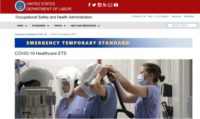For the latest about OSHA guidance and vaccine mandates, please see our most recent ENR coverage of the ongoing issue.
New guidance from the U.S. Occupational Safety and Health Administration is causing contractors to change their COVID-19 vaccine requirements, and many of them criticize the guidance as diametrically opposed to the Biden administration's stated desire to increase vaccinations.
Update: EEOC Says It Will Create Specialized Return-to-Work Guidelines
On April 20, OSHA released the new guidance in the frequently asked questions section of its website for COVID-19 safety compliance.
The question asks whether an employer should record adverse reactions to COVID-19 vaccination if the employer requires the vaccine. OSHA states that if a vaccine is required, then any adverse reaction is considered work-related and therefore it must be recorded. Under OSHA rules, most employers with more than 10 employees are required to keep a record of serious work-related injuries and illnesses. Recorded injuries and illnesses become part of a contractors safety record.
TAKE OUR POLL: Do you agree with OSHA's guidance on employers requiring vaccines?
This is the actual text of the new question and answer on the OSHA website:
"If I require my employees to take the COVID-19 vaccine as a condition of their employment, are adverse reactions to the vaccine recordable?
"If you require your employees to be vaccinated as a condition of employment (i.e., for work-related reasons), then any adverse reaction to the COVID-19 vaccine is work-related. The adverse reaction is recordable if it is a new case under 29 CFR 1904.6 and meets one or more of the general recording criteria in 29 CFR 1904.7."
In response, several large contractors said they have changed or will change their vaccination policy to only recommend—not require—a vaccine.
"We, sadly, had to back off our (employee vaccination) mandate because OSHA did something I don't understand at all," said Bob Clark, founder and executive chairman of Clayco in a recent ENR Critical Path podcast. "I side with OSHA frequently, we're in its VIP program, but on this they're just wrong. It's a terrible decision they've made and I think it'll be overturned."
Clark said Clayco, which participated in crafting the initial Centers for Disease Control guidance on construction site safety during the pandemic, would be communicating with OSHA through members of congress to seek changes to the guidance. A spokeswoman for OSHA did not immediately return messages asking for clarification of the new guidance. Construction industry groups universally panned the guidance and said it would hurt their efforts to encourage employees to get vaccinated.
"What they put forward could potentially discourage employers from supporting their workers getting the vaccine," said Kevin Cannon, senior director of safety and health services at the Associated General Contractors of America. "AGC is not in support of any mandate, however we participated, April 19th through 23rd, in vaccine awareness week. We had a lot of members who were in chapters that supported the event. We even had some who hosted vaccine clinics on an active job site or in their offices."
Cannon said some member contractors may have changed their approach to those events had they known, at the time, they could potentially "be on the hook for recording these potential adverse reactions."
AGC is also concerned the rule puts contractors working on projects such as hospital expansions, where vaccination could potentially be an owner condition of being present on the site, in a difficult position.
Cannon said AGC has reached out to OSHA as part of the Construction Industry Safety Coalition, a group of 30 industry groups from all major types of construction, to give OSHA more context as to the burden the guidance places on contractors. AGC plans to submit a letter to the agency with chapter input to the agency.
'Caused Significant Confusion'
Donna Reichle, senior director of public affairs at the Associated Builders and Contractors said, "We agree OSHA has caused significant confusion with this guidance. Industry groups will be seeking clarification from the agency."
OSHA has been working for weeks on an all-industries COVID-19 emergency safety standard, which is now being reviewed by the Biden administration's Office of Management and Budget. Release of the final rule is believed to be coming soon. It is possible the new safety standard could preempt or replace the April 20 guidance to employers. It's unclear, at this point, if separate rules will be made for industries such as construction, where liability and risk are defined differently than in industries where work takes place in a company facility.
The number of overall COVID-19 hospitalizations and fatalities also greatly affects the recommendations CDC, OSHA and the various states have released. Cannon said the current guidance, if left unchanged, has the potential to undo months of industry work to encourage vaccination of construction workers.
"It's almost like they haven't talked to the rest of the Biden administration about the goal of getting as many people vaccinated as possible," said Brian Turmail, AGC vice president of public affairs.
Update: On July 27, OSHA released new guidance that recommends fully vaccinated workers in areas of substantial or high community transmission wear masks in order to protect unvaccinated workers and also recommended that fully vaccinated workers who have close contacts with people with coronavirus wear masks for up to 14 days unless they have a negative coronavirus test at least 3-5 days after such contact (updated Sept. 10).





